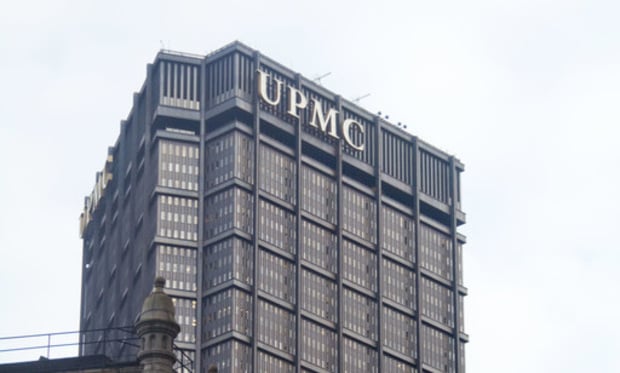UPMC Asks Pa. Supreme Court to Reconsider Decision Striking Down MCARE Statute of Repose
The high court's analysis underpinning the Oct. 31 decision "clashed" with recent precedent interpreting the same statute, said an attorney for a Pittsburgh-based health care nonprofit.
November 13, 2019 at 06:24 PM
5 minute read
 University of Pittsburgh Medical Center. Photo: Erika J Mitchell/Shutterstock.com
University of Pittsburgh Medical Center. Photo: Erika J Mitchell/Shutterstock.com
Nonprofit health care provider UPMC has asked the Pennsylvania Supreme Court to reconsider its decision last month to strike down the statute of repose under the state's MCARE health law, saying its analysis was "gravely flawed."
The hospital system filed an application for reconsideration Wednesday in the case Yanakos v. UPMC, in which a sharply divided court said the statute of repose violates the Pennsylvania Constitution's guarantee of open access to the courts.
However, according to the 15-page application for reargument filed by Dickie, McCamey & Chilcote attorney John Conti, the court's analysis underpinning the Oct. 31 decision "clashed" with recent precedent interpreting the same statute, was based on an issue that was not before the court and improperly disregarded the General Assembly's policy objectives in enacting the Medical Care Availability and Reduction of Error (MCARE) Act's statute of repose.
"The court's decision sets aside bedrock jurisprudential foundation for statutes of repose and replaces it with evidentiary quicksand upon which no legislature could erect a sound statute," Conti said.
Ruling 4-3, the high court in Yanakos struck down as unconstitutional MCARE's seven-year limitation on bringing medical malpractice lawsuits. Justice Sallie Updyke Mundy wrote the court's majority opinion. She was joined by Justices Debra Todd and Kevin Dougherty. Justice Christine Donohue concurred with the result, and Justice David Wecht filed a dissent that Chief Justice Thomas Saylor and Justice Max Baer joined.
According to Mundy, the defendants in the case needed to show that the General Assembly's enactment of the MCARE Act's statute of repose was "substantially or closely related to an important government interest." However, Mundy said the defendants failed to meet that burden.
"There was no evidence to show the initially proposed four-year statute of repose would provide actuarial certainty, except that it 'seemed like a reasonable resolution' to 'provide some stability and predictability' to insurers," Mundy said, citing the legislative history in first proposing a four-year statute of repose. "There is no evidence in the legislative history as to how the General Assembly arrived at a seven-year statute of repose with exceptions for foreign objects cases and minors. The legislature did not cite any statistics on the number of medical malpractice actions that are commenced after seven years of the occurrence giving rise to the action. There is no indication that such a time period, as opposed to a longer or shorter period, will have any effect on malpractice insurance costs."
However, in the brief seeking reargument, Conti said the economic justification for the statute of repose was an issue the court raised itself after it had been waived by the plaintiff, so the defendants were not given the opportunity to address the issue.
Further, he argued that the analysis overlooked the significant governmental interest that the statute of repose served. According to Conti, the central goal of the statute of repose was to create predictable and stable insurance markets for health care providers, and, although reduction of insurance costs was a side benefit, it was not the primary objective. He also noted that, although the court said the choice of a seven-year statute of repose was "arbitrary," the court ignored the fact that the period correlates with the length of time hospitals are required to keep their medical records.
Regarding prior precedent, Conti said the court's analysis in Yanakos was "contradictory" to the reasoning behind its 2017 decision in Dubose v. Quinlan, which was also authored by Mundy, with Dougherty and Todd joining. That decision, which dealt with MCARE's statute of limitations, determined that the time period for filing survival actions could be extended until two years after death.
Conti contended that, although the court in Yanakos said there was insufficient legislative history supporting the statute of repose, the Dubose ruling upheld the statute of limitations "despite the absence of any legislative history." The analysis in Yanakos, he said, "clashed" with Dubose, and would essentially require the legislature to "provide research on the order of an academic study supportive of all elements of a given piece of legislation."
"If this decision is allowed to stand, it will represent a judicial feat imbued with considerable irony whereby a statute of limitations was fashioned despite the absence of legislative history and then the sole limiting constraint on that very statute was dissolved due to the absence of legislative history," Conti said. "Of Section 513, it could be said, what the legislature enacted is now gone, what the court created is all that remains."
Conti referred to the brief when reached for comment.
Patrick Cavanaugh of Del Sole Cavanaugh Stroyd, who represented the plaintiffs, did not return a message seeking comment Wednesday afternoon.
This content has been archived. It is available through our partners, LexisNexis® and Bloomberg Law.
To view this content, please continue to their sites.
Not a Lexis Subscriber?
Subscribe Now
Not a Bloomberg Law Subscriber?
Subscribe Now
NOT FOR REPRINT
© 2025 ALM Global, LLC, All Rights Reserved. Request academic re-use from www.copyright.com. All other uses, submit a request to [email protected]. For more information visit Asset & Logo Licensing.
You Might Like
View All
Superior Court Rejects Pa. Hospital's Challenge to $7.3M Med Mal Judgment
3 minute read
Longtime Reed Smith Health Care Partner Opts for Solo Practice Over Retirement
3 minute read
Pa. Appeals Court: Trial Judge Dismissed Med Mal Claims Without Giving Plaintiffs Proper Time to Fight Back
4 minute read
Pa. Hospital Agrees to $16M Settlement Following High Schooler's Improper Discharge
4 minute readLaw Firms Mentioned
Trending Stories
Who Got The Work
J. Brugh Lower of Gibbons has entered an appearance for industrial equipment supplier Devco Corporation in a pending trademark infringement lawsuit. The suit, accusing the defendant of selling knock-off Graco products, was filed Dec. 18 in New Jersey District Court by Rivkin Radler on behalf of Graco Inc. and Graco Minnesota. The case, assigned to U.S. District Judge Zahid N. Quraishi, is 3:24-cv-11294, Graco Inc. et al v. Devco Corporation.
Who Got The Work
Rebecca Maller-Stein and Kent A. Yalowitz of Arnold & Porter Kaye Scholer have entered their appearances for Hanaco Venture Capital and its executives, Lior Prosor and David Frankel, in a pending securities lawsuit. The action, filed on Dec. 24 in New York Southern District Court by Zell, Aron & Co. on behalf of Goldeneye Advisors, accuses the defendants of negligently and fraudulently managing the plaintiff's $1 million investment. The case, assigned to U.S. District Judge Vernon S. Broderick, is 1:24-cv-09918, Goldeneye Advisors, LLC v. Hanaco Venture Capital, Ltd. et al.
Who Got The Work
Attorneys from A&O Shearman has stepped in as defense counsel for Toronto-Dominion Bank and other defendants in a pending securities class action. The suit, filed Dec. 11 in New York Southern District Court by Bleichmar Fonti & Auld, accuses the defendants of concealing the bank's 'pervasive' deficiencies in regards to its compliance with the Bank Secrecy Act and the quality of its anti-money laundering controls. The case, assigned to U.S. District Judge Arun Subramanian, is 1:24-cv-09445, Gonzalez v. The Toronto-Dominion Bank et al.
Who Got The Work
Crown Castle International, a Pennsylvania company providing shared communications infrastructure, has turned to Luke D. Wolf of Gordon Rees Scully Mansukhani to fend off a pending breach-of-contract lawsuit. The court action, filed Nov. 25 in Michigan Eastern District Court by Hooper Hathaway PC on behalf of The Town Residences LLC, accuses Crown Castle of failing to transfer approximately $30,000 in utility payments from T-Mobile in breach of a roof-top lease and assignment agreement. The case, assigned to U.S. District Judge Susan K. Declercq, is 2:24-cv-13131, The Town Residences LLC v. T-Mobile US, Inc. et al.
Who Got The Work
Wilfred P. Coronato and Daniel M. Schwartz of McCarter & English have stepped in as defense counsel to Electrolux Home Products Inc. in a pending product liability lawsuit. The court action, filed Nov. 26 in New York Eastern District Court by Poulos Lopiccolo PC and Nagel Rice LLP on behalf of David Stern, alleges that the defendant's refrigerators’ drawers and shelving repeatedly break and fall apart within months after purchase. The case, assigned to U.S. District Judge Joan M. Azrack, is 2:24-cv-08204, Stern v. Electrolux Home Products, Inc.
Featured Firms
Law Offices of Gary Martin Hays & Associates, P.C.
(470) 294-1674
Law Offices of Mark E. Salomone
(857) 444-6468
Smith & Hassler
(713) 739-1250





